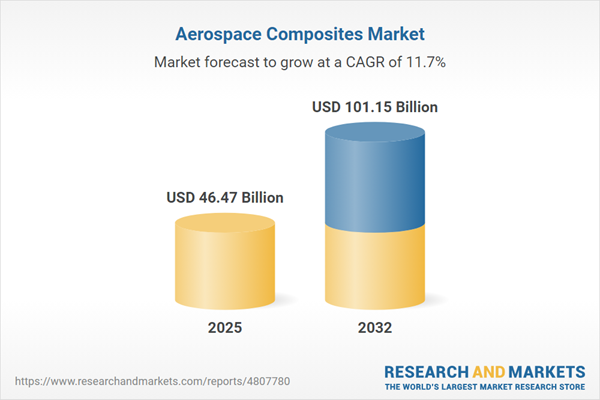Speak directly to the analyst to clarify any post sales queries you may have.
The aerospace composites market is advancing rapidly as industry leaders respond to technological change, sustainability mandates, and evolving regulations. Organizations that strategically adapt to these shifts are positioned to strengthen competitiveness and capture opportunities across the aerospace value chain.
Market Snapshot: Aerospace Composites Market Growth Trajectory
The aerospace composites market grew from USD 41.88 billion in 2024 to USD 46.47 billion in 2025. It is projected to expand at a compound annual growth rate (CAGR) of 11.65%, reaching USD 101.15 billion by 2032.
Scope & Segmentation: Addressing Diverse Market Segments, Applications, and Regions
This report delivers a comprehensive breakdown of the aerospace composites sector, benchmarking core segments, technologies, applications, and markets:
- Resin Types: Thermoplastic, Thermoset
- Material Types: Aramid Fiber, Carbon Fiber, Ceramic Fiber, Glass Fiber
- Processing Technologies: Autoclave, Automated Fiber Placement, Hand Layup, Pultrusion, Resin Transfer Molding
- Applications: Business Jet, Commercial Aircraft, Helicopter, Military Aircraft (Fighter Aircraft, Transport & UCAV)
- Sales Channels: Aftermarket, OEM
- Regional Coverage: Americas (United States, Canada, Mexico, Brazil, Argentina, Chile, Colombia, Peru), Europe, Middle East & Africa (United Kingdom, Germany, France, Russia, Italy, Spain, Netherlands, Sweden, Poland, Switzerland, United Arab Emirates, Saudi Arabia, Qatar, Turkey, Israel, South Africa, Nigeria, Egypt, Kenya), Asia-Pacific (China, India, Japan, Australia, South Korea, Indonesia, Thailand, Malaysia, Singapore, Taiwan)
- Company Analysis: Albany International Corporation, Bally Ribbon Mills, BASF SE, General Electric Company, Hexcel Corporation, Hexion Inc., Huntsman International LLC, Lee Aerospace, Inc., Mitsubishi Chemical Holdings Corporation, Plastic Reinforcement Fabrics Ltd., Rolls-Royce PLC, SGL Carbon SE, Solvay S.A., Spirit AeroSystems, Inc., TEIJIN Limited, Toray TCAC Holding B.V., Owens Corning, AXIOM Materials by Kordsa, Park Aerospace Corp., Hyosung Advanced Materials Corporation, TPI Composites Inc., Airborne, GKN PLC
Key Takeaways for Senior Decision-Makers
- Aerospace composites are redefining operational models with lighter, stronger materials enabling new aircraft design approaches.
- Sustainability mandates are accelerating the shift toward recyclable thermoplastic resins and bio-based reinforcements, driving collaborative innovation among suppliers and OEMs.
- Advanced automation, including machine learning-driven fiber placement and robotic layup, is boosting precision, production speed, and consistency in composite manufacturing.
- Digital twin integration is transforming supply chain visibility and real-time quality assurance, supporting predictive maintenance and component traceability.
- Emerging regions, especially Asia-Pacific, are strengthening their role as critical production and skill development hubs in response to global fleet expansion and joint ventures.
Tariff Impact: Navigating Regulatory Changes and Domestic Innovation
The 2025 implementation of United States tariffs on raw fibers and resins elevated material costs and prompted manufacturers to re-examine sourcing strategies. Industry leaders responded by qualifying domestic suppliers, investing in regional production, and accelerating recycling initiatives to bolster supply chain resilience. These adjustments introduced short-term complexity but fostered long-term robustness and local innovation across the market.
Methodology & Data Sources
This aerospace composites analysis is underpinned by primary interviews with OEM professionals, supply chain managers, and material scientists, supplemented by secondary research into patents, regulatory documents, technical papers, and industry reports. Multi-source triangulation and peer review ensure data reliability and actionable insights for strategic decision-making.
Why This Report Matters: Strategic Insights for Aerospace Leaders
- Gain granular visibility across resin systems, process technologies, and regional demand patterns to inform investment and sourcing decisions.
- Leverage technology adoption trends and collaborative R&D initiatives shaping industry competitiveness.
- Understand the regulatory and supply chain landscape, including tariff-driven shifts and circular economy strategies, to mitigate risk and strengthen market position.
Conclusion
The aerospace composites sector is at an inflection point, shaped by regulatory initiatives, digital transformation, and evolving supply chains. Decision-makers equipped with this market intelligence can align their strategies to capture growth and enhance operational resilience.
Additional Product Information:
- Purchase of this report includes 1 year online access with quarterly updates.
- This report can be updated on request. Please contact our Customer Experience team using the Ask a Question widget on our website.
Table of Contents
3. Executive Summary
4. Market Overview
7. Cumulative Impact of Artificial Intelligence 2025
Companies Mentioned
The companies profiled in this Aerospace Composites market report include:- Albany International Corporation
- Bally Ribbon Mills
- BASF SE
- General Electric Company
- Hexcel Corporation
- Hexion Inc.
- Huntsman International LLC
- Lee Aerospace, Inc.
- Mitsubishi Chemical Holdings Corporation
- Plastic Reinforcement Fabrics Ltd.
- Rolls-Royce PLC
- SGL Carbon SE
- Solvay S.A.
- Spirit AeroSystems, Inc.
- TEIJIN Limited
- Toray TCAC Holding B.V.
- Owens Corning
- AXIOM Materials by Kordsa
- Park Aerospace Corp.
- Hyosung Advanced Materials Corporation
- TPI Composites Inc.
- Airborne
- GKN PLC
Table Information
| Report Attribute | Details |
|---|---|
| No. of Pages | 198 |
| Published | November 2025 |
| Forecast Period | 2025 - 2032 |
| Estimated Market Value ( USD | $ 46.47 Billion |
| Forecasted Market Value ( USD | $ 101.15 Billion |
| Compound Annual Growth Rate | 11.6% |
| Regions Covered | Global |
| No. of Companies Mentioned | 24 |









